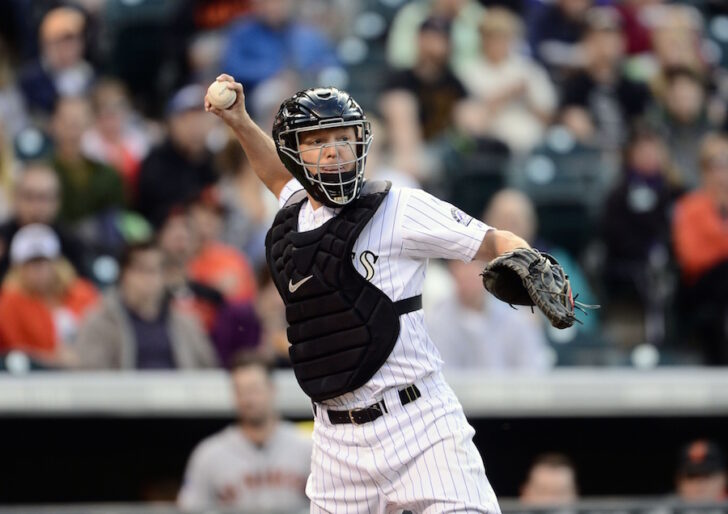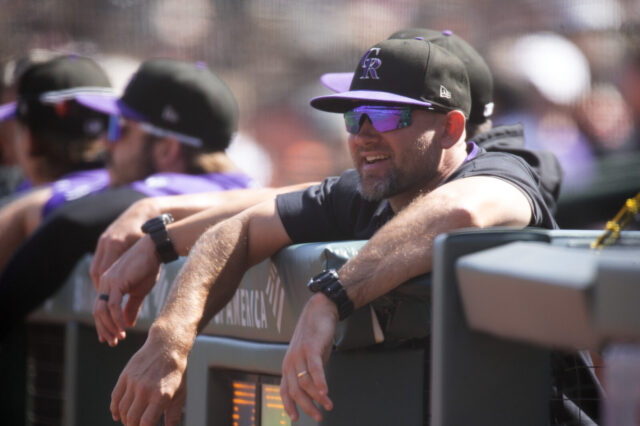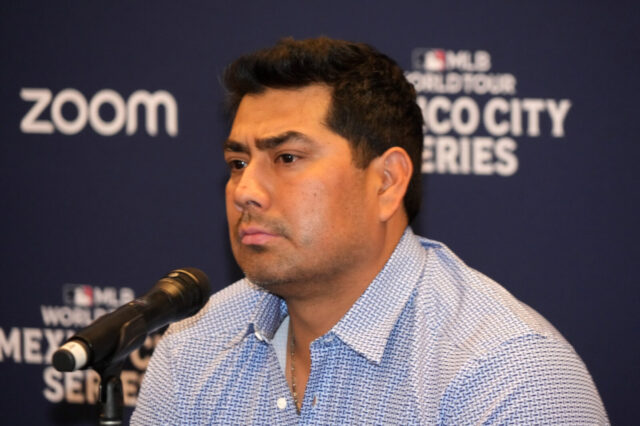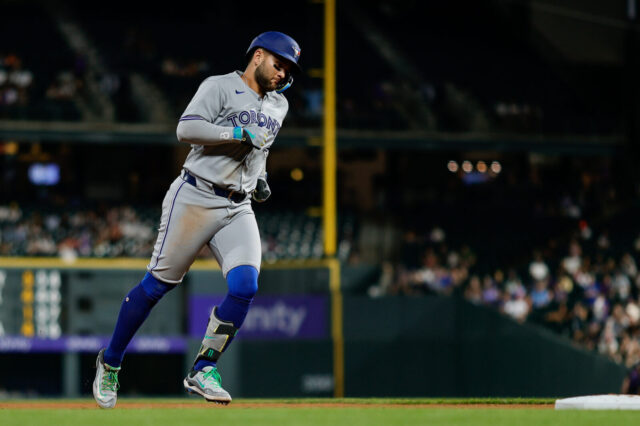For the better part of a decade, the Colorado Rockies struggled to find an “answer” at second base. Clint Barmes was “serviceable,” Kaz Matsui was a “sparkplug” but inconsistent (no “quotes” needed), Marco Scutaro, Jamey Carroll, Aaron Miles, Ronnie Belliard, Brent Butler and Todd Walker were all “guys who wore Rockies hats” (seldom for more than a year). The names extend even further back than 2001, but there’s no need to rehash them. In December 2011, Colorado traded for D.J. LeMahieu who saw 50/50 playing time in 2012 and in the three years since has emerged as one of the premier defensive second basemen in the game, not to mention a halfway decent hitter.
The same search has been ongoing (with some minor interruptions) at the catcher position for the better part of the franchise’s existence. Here’s a shocking fact: In 23 seasons, Colorado has just three catchers who have been behind the plate for the bulk of the club’s games for more than two seasons. Confused? I’ll spell it out.
Joe Girardi was the primary catcher (most games played) in 1993, ’94 and ’95 (although he split time nearly 50/50 with Danny Sheaffer the first two years). Wilin Rosario had more games played than any other catcher on the roster in 2012, ’13 and ’14 (although that comes with a major asterisk as he was also pinch-hitting and playing first base across that span, splitting time behind the plate with Ramon Hernandez, Yorvit Torrealba and Michael McKenry in each of those years, respectively). Only Chris Iannetta did it in 2008, ’09 and ’11 in a nearly full-time role.
It’s scary that two of the guys to have the “main” stat line as Rockies catchers weren’t even on full-time catching duty and even more frightening that in 23 years the Rockies haven’t been able to find (or keep) an anchor-type player at arguably one of the most important positions on the field (especially when home field is Coors Field).
Over the years, three other guys have held down the primary catching duties for back-to-back years – Kirt Manwering, Charles Johnson, and Yorvit Torrealba. And names like Henry Blanco, Brent Mayne, and Miguel Olivo litter the list of eight different guys whose tour as the Rockies No. 1 catcher lasted just one year.
Nick Hundley currently resides in the last group, for his duties performed in 2015. Barring some unusual circumstance, he’ll join Manwering, Johnson and Torrealba. His future beyond that, however, is unclear. The 2016 season will be the last of a two-year deal and his neck injury late in 2015 have the Rockies brass feeling circumspect about anything beyond next year when he will be 33 years old and an unrestricted free agent.
Offensively, Hundley benefitted from Coors Field, posting his first-ever .300-plus year with a .301 average in 103 games. He also had his second-best career numbers in home runs and RBI in 2015 and a career-high with 21 doubles. He broke the 100-hit threshold for the first time in his career, as well.
On defense, he ranked 10th in the National League in both fielding percentage and stolen base percentage among catchers with more than 300 innings. The biggest knock on his defense might be that he was calling pitches and receiving for the team with the worst ERA in baseball, but that’s a distinction Colorado has claimed for each of the past two years (and they have been the worst in the National League now four years running). Hundley calls a good game, he just doesn’t have the pitchers to execute it.
As a total package, Hundley is the most complete catcher the Rockies have had since their very first one, Girardi. It’s unfortunate, because at 32 years old and with a chip fracture in his neck that ended the 2015 season, Hundley very likely won’t be viewed by Rockies brass a long-term investment. That means that the search for an anchor behind the dish will continue into 2017 and perhaps beyond. Now that Michael McKenry has been outrighted and will test the free agent waters, that leaves the door open for career minor leaguer Dustin Garneau and highly-regarded prospect Tom Murphy.
Both saw time late in 2015 and played as well as could be expected, but Murphy, four years Garneau’s junior at 24 years old, appears to be the next in line to replace Hundley. He hit .100 points higher than Garneau (in half as many at-bats), and his ascent to the Major League ranks has been much more swift. Murphy made it to the show in just four years and shined in his limited opportunities this September.
Colorado’s biggest need, without a doubt, is pitching. But it also has a stable of young pitchers like Eddie Butler and John Gray who are knocking on the Major League door – especially as the organization struggles to sign viable free agents. Kyle Kendrick’s miserable year and parting shots about not being able to pitch at altitude won’t help to lure any quality arms here in the years to come. That leaves the Rockies in a curious situation with how to handle duties behind the dish, as well.
Hundley will no doubt be the starter next year and Murphy ought to be the backup. Garneau may be the more seasoned player at this point, but Murphy shouldn’t be held back at this point. He could learn a tremendous amount about game management backing up Hundley, plus begin adjusting to hitting big league pitching while the team remains in a (still) building mode.
And depending on what the Rockies decide to do with Gray and Butler, Murphy could serve in an even greater platoon role with Hundley. If those two are going to factor more greatly into the starting rotation, Colorado could go one of two ways:
They could assign Hundley the task of catching the younger pitchers, helping to shepherd them in their development, along with Jorge De La Rosa, who’s going to go out and get Colorado double-digit wins, and a fourth starter. Hundley needs to catch De La Rosa whenever possible, as their battery gives the Rockies the best chance to win every five days. This scenario would leave Murphy to catch one of Colorado’s other two starters, whether that be Chad Bettis, Yohan Flande, Chris Rusin or any other “arms” they march out. This would give Murphy reps with established (though not necessarily successful) Major League pitchers and speed his development.
On the other hand, they could elect to play Murphy with those younger pitchers and give him a chance to develop a rapport with them along the way. That would free up Hundley to stick with the veterans and try and scratch out a few more wins along the way. It would also give Hundley more rest. In eight years in the Majors, Hundley has averaged less than 100 games per year, so he should have plenty of tread on the tires. But catching at Coors Field can do to catchers what the Presidency does to politicians. Murphy can save Hundley some gray hairs by lightening the load.
What Colorado can’t afford to do is maintain the status quo with the rotation and expect Hundley to have any interest in staying in Colorado (besides the beautiful weather, great schools and picturesque views) beyond 2016. Hundley should have at least another two years as a full-time starter and could be a great platoon or veteran backup to Murphy in 2018 and beyond, but the Rockies need to show that the staff he’s going to be asked to manage is on the upswing.
Whether that’s with the development of Gray and Butler (and then guys like Jeff Hoffman and Kyle Freeland) or by some miracle acquisition of legitimate free agents, Colorado can’t squander what they have currently in Nick Hundley and in the potential of Tom Murphy. As Colorado has seen over its 23 seasons, finding a reliable body behind the plate is no small task. They currently have one of the more consistent all-around catchers the franchise has ever seen, and that must be rewarded by showing a commitment to improving the pitching staff and managing his workload to avoid future injuries.
Hundley is of the class of player like Girardi and Iannetta (at least as they were as Rockies). Colorado needs to manage his future with the same wisdom with which Hundley manages a games behind the plate for them.



